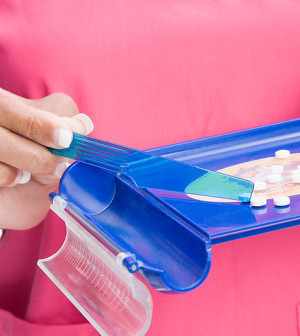- Skip Storing This Everyday Product in the Fridge Door
- Green Tea + B3 Pairing May Boost Brain Health
- Navigating Your Midlife Crisis: Embracing New Possibilities
- City Raccoons Showing Signs of Domestication
- Mapping the Exposome: Science Broadens Focus to Environmental Disease Triggers
- One Week Less on Social Media Linked to Better Mental Health
- Your Brain Changes in Stages as You Age, Study Finds
- Some Suicide Victims Show No Typical Warning Signs, Study Finds
- ByHeart Formula Faces Lawsuits After Babies Sickened With Botulism
- Switch to Vegan Diet Could Cut Your Greenhouse Gas Emissions in Half
Many Take Opioids Reluctantly for Back Pain: Survey

Millions of Americans with back pain take powerful and potentially addictive opioid painkillers. But in a new survey, many say the drugs provide only limited relief and they worry about taking them.
The survey included more than 2,000 people with low back pain. Of the nearly half who were currently taking opioids, only 13 percent said the drugs were very successful at relieving their pain. Forty-four percent said the drugs were somewhat successful, 31 percent said they were moderately successful and 12 percent said they were unsuccessful.
Seventy-five percent said the drugs had side effects such as constipation (65 percent), sleepiness (37 percent), thinking and memory problems (32 percent) and drug dependence (29 percent).
“Patients are increasingly aware that opioids are problematic, but don’t know there are alternative treatment options,” said survey author Dr. Asokumar Buvanendran. He is director of orthopedic anesthesia at Rush University Medical Center in Chicago.
Stigma was another concern for these patients. Forty-one percent of those taking opioids said they felt judged for their use of the drugs. Even though 68 percent of the patients had also taken antidepressants, only 19 percent felt any stigma from using those medications.
The study was to be presented Sunday at the annual meeting of the American Society of Anesthesiologists (ASA), in Chicago.
“While some patients may benefit from opioids for severe pain for a few days after an injury, physicians need to wean their patients off them and use multi-modal therapies instead,” Buvanendran said in an ASA news release. He is also vice chair of the ASA’s Committee on Pain Medicine.
These other therapies include physical therapy, bracing, nerve blocks, nerve ablation techniques (where nerve cells are destroyed to ease pain) or implantable devices, he said.
Anti-inflammatory medications and alternative therapies such as biofeedback and massage can also help, Buvanendran added.
Research presented at medical meetings is viewed as preliminary until published in a peer-reviewed journal.
The United States is in the grip of an opioid epidemic.
According to the U.S. Department of Health and Human Services, the rate of overdose deaths involving opioids — including prescription opioid pain relievers and heroin — nearly quadrupled since 1999. And more than 165,000 people have died from prescription opioid overdoses.
More information
The American Academy of Family Physicians has more on low back pain.
Source: HealthDay
Copyright © 2025 HealthDay. All rights reserved.










